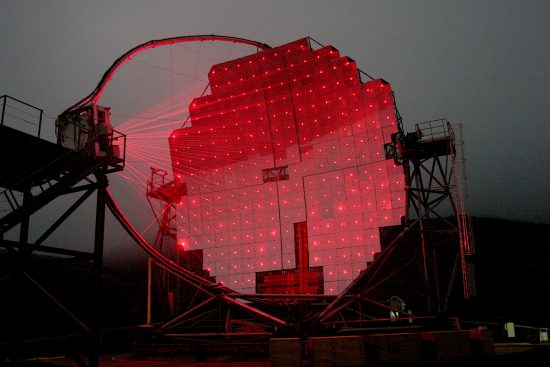
March 2, 2020
Plasma is the foundation for all celestial phenomena.
Electric Universe advocates argue that a flow of electric charge in plasma generates electromagnetic fields that constrict the plasma. As previous Pictures of the Day point out, that constricted channel is known as a Bennett pinch, or z-pinch. The pinched filaments remain coherent over long distances, spiraling around each other in helical structures that transmit power through space.
Galactic flares and jets are easily modeled with the proper experimental devices. There is no evidence that matter can be compressed to nearly infinite density, and what astrophysicists witness in space is “pinched” plasma filaments forming plasmoids. When the current density gets too high, double layers in the circuit catastrophically release their excess energy and appear as gamma ray bursts or X-rays or flares of ultraviolet light.
Using the MAGIC telescope in the Canary Islands, astronomers detected an “…extremely powerful outburst of gamma rays” coming from a galaxy known as IC 310. The flash exhibited “very rapid flux variations”. In other words, the gamma ray emissions sparkled like a lightning bolt.
Infrared and X-ray telescopes confirm the existence of a plasma-focus plasmoid at the heart of the Milky Way: a high-energy electrical formation that powers its galactic circuit. Since dust blocks visible light, viewing the core has not been possible until the advent of telescopes that can “see” infrared and X-ray light. Radiation from the Milky Way’s plasmoid is typical of that given off by highly excited stars, indicating extremely strong electrical stress. The strong electrical field in the plasmoid acts as a particle accelerator. Electrons accelerated to high speeds spiral in its magnetic field, emitting high frequency wavelengths.
In a galactic circuit, electrical power flows inward along the spiral arms, lighting the stars as it goes, and is concentrated and stored in the central plasmoid. When the plasmoid reaches a threshold density, it discharges, usually along the galaxy’s spin axis. This process can be replicated in a laboratory with the plasma focus device.
The jet of charged particles seen erupting from IC 310 is thought to result from rotational energy generated by supermassive black hole in its core. Conventional theories insist that gravity is the dominant force in the Universe, so any anomalous observations are forced into that theoretical framework. That narrow viewpoint produces scientific papers whose common refrain is one of “puzzlement” and “unexpected results”. Although the MAGIC data provokes comments that seem to suggest electrical activity as the foundation for what is happening in IC 310, the conclusion is that kinetic effects, such as angular momentum, power its radio jet and gamma ray outbursts.
Flares and jets spewing from galaxies are thought to be caused by stars traveling too close to their central supermassive black holes where they are torn apart by tidal forces, or “rotational energy”. Most of the star’s gas escapes the black hole, but a small quantity is captured by the immense gravity and forms a rotating disk. Closer to the black hole, heat generated by molecular collisions tears the atoms apart and the disk of gas glows in extreme ultraviolet and X-rays. When matter eventually falls into the black hole, gamma rays burst out. That is a theory that ignores electricity’s capabilities.
Despite the idea’s erroneous origin in spinning gravity fields, there are lightning flashes taking place in the center of IC 310.
Stephen Smith
The Thunderbolts Picture of the Day is provided through the generous support of the Mainwaring Archive Foundation.












